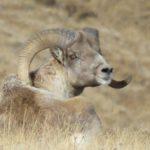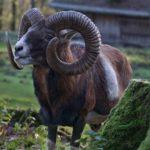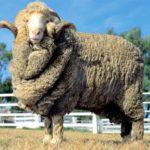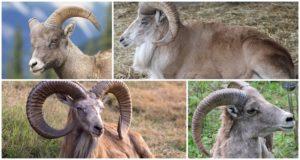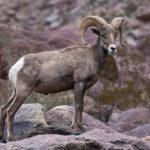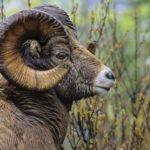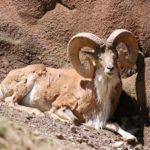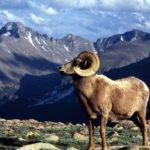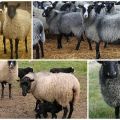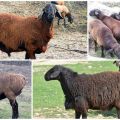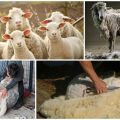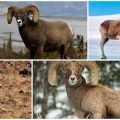What do rams look like and who do they come from, where do artiodactyls live?
Sheep are called wild representatives of small ruminants. In agriculture, the name domestic sheep is used. Animals differ in size, coat properties and horn length. The herd instinct and the seasonality of reproduction are inherited by agricultural sheep from their wild ancestors. As a result of selection, heavy meat, long-haired and dairy breeds appeared. The idea of what a wild sheep looks like gradually faded.
Description of animals
A ram is a cloven-hoofed animal of the mammalian class. 8 thousand years ago, man tamed wild rams, began to eat milk and meat, and make clothes from wool. The Latin name for the animal is "ovis ammon". The Mongolian name "argali" is translated as "wild sheep".
The appearance of a ram:
- weight - 70-160 kilograms;
- height at the withers - 55-100 centimeters;
- body length - 60-110 centimeters;
- straight or humped profile.
Weight and body measurements vary by breed. Females weigh less - up to one hundred kilograms. The minimum tail length of rams is 9.5 centimeters. The horns of mountain rams are sharp at the ends, twisted into spirals and reach 190 centimeters in length. The horns of females are shorter - 50 centimeters.
Some body parts of domestic and wild rams differ:
| Sign | At home ram | At the wild ram |
| Wool | Twisted by rings | Lays down exactly |
| Horns | Only in males, rarely in females | In males and females |
| Skull structure | Narrow eye sockets | Oval eye sockets |

The brain size of a domestic ram is smaller than that of a wild ram. Also domesticated animals have a longer tail. The rams have a special jaw structure. Canines and incisors are located just below. The inclination of the incisors at an obtuse angle to the jaw makes it easier for sheep to bite off the grass than other herbivores. In sheep breeding, a male is called a ram, a female in a general sense is called a sheep, and not a sexually mature female is called a bright one. A cub of domestic and wild sheep is called a lamb.
Wild rams are distinguished by a variety of colors: light yellow, red-brown, dark gray. The dark upper body is separated from the light belly by a dark stripe. The color of females is lighter than that of males. In summer, spots appear and the coat becomes shorter. In winter, the short hairline is replaced by a long one.
Pure black or white color is typical only for farm animals.
Varieties of rams and sheep
Wild animals differ in appearance: the length and curl of the horns, body size, color. Types of wild sheep:
- argali;
- urian;
- mouflon.
In nature, they live on an area of 30 kilometers, in winter they feed closer to the valleys, gather in a herd of up to a thousand heads. Wild sheep are called aboriginal, and domestic breeds are cultivated. In agriculture, the name common sheep is also used. Animals are divided according to productivity:
- meat;
- dairy;
- woolen;
- greasy.
There are also mixed types (which give two products) - meat-greasy and meat-wool. Domestic sheep are descendants of mouflon mountain rams. From their wild ancestors, they retained the herd instinct and submission to the leader. The largest and strongest horned ram becomes the leader. Horned sheep are sometimes found among dairy and meat species.
Habitat
Wild rams live in Europe, Asia, the Mediterranean islands and the United States. Mouflons are found in Sardinia, Corsica and Cyprus. India, Iran, Kazakhstan and the Caucasus are countries where Asian varieties are common. Wide range of wildlife in North America - from Canada to the coast of California.

Wild sheep are found in the following areas:
- the protected ridge Nuratau in Uzbekistan;
- on the hills, rocky plateaus of eastern Mongolia;
- at the Khunjirab National Park in Pakistan;
- in the Damodar Kunda and Dolpo region of Nepal;
- on the eastern slopes of the Tien Shan mountains;
- in the Pamirs, in the Vakhjir valley in Afghanistan.
In Russia, wild sheep are common in the east of Siberia. The main natural habitat of sheep is mountains. They rarely live in deserts. Domestic sheep have been raised since ancient times in Armenia. In the modern world, sheep farms are located in Australia, the islands of New Zealand, Great Britain. Sheep wool produced in the Caucasus, Kazakhstan, China, Tibet and in the southern regions of Russia is famous for its high quality.
What rams eat
According to the way of feeding, rams are classified as herbivores. Wild animals eat sedge and contribute to high yields of useful grasses. Argali of Kazakhstan eat more varied: flowers, fruits and twigs. They make up for the lack of mineral salts by using saline soil. Herds travel long distances in drought to get to lakes and get drunk. In winter, they drink water from thawed mountain streams.
Diet of domestic sheep:
- green fodder - is the basis of food in summer, grass contains the necessary vitamins and minerals and replaces compound fodder. Sheep eat meadow grasses: hogweed, clover, timothy. At the end of summer, sheep receive nutrients from green rye and oats;
- silage - green mass, crushed and preserved in a vacuum, replaces succulent forage in winter. Silage consists of corn, sunflower, vegetable tops. The product is high-calorie and nutritious, like fresh grass;
- hay, straw - alfalfa, clover, barley and oat stalks are dried to feed sheep in winter. All-purpose plant food retains nutrients when properly prepared and stored;
- vegetables - sheep get fiber from root crops and melons. Fodder beets, pumpkin, squash and carrots contain vitamins needed for the health of cat sheep and the development of lambs. Vegetables are necessarily included in the diet of animals that provide milk and wool;
- concentrated feed - grains of wheat, oatmeal, barley, corn, bran.
A ram is a ruminant with a four-chambered stomach. The digestive system of sheep is distinguished by numerous microflora and is designed so as to digest tough plant foods.

Behavior in the natural environment
Sheep feed in the daytime and rest at night. In the heat, they spend the day in the shade, and they get food at dusk. The order of grazing of domestic sheep is based on this behavior. Females with calves gather in separate groups.Males live alone or also form a separate group with a hierarchy. It is headed by the most powerful ram, who has proven his superiority in fights.
In wild populations, adult females predominate. Young animals make up 20 percent of the group. Sheep keep close to each other so as not to lose any of the members of the herd. Animals are sociable not only in their group. They also make contact with representatives of other communities.
Groups with males migrate in search of food, and in summer they climb high along the mountain slopes. At the height, insects do not pester them. Also, migration begins due to poaching, fires, hunger.
If one of the herd members noticed a danger, he makes a sign to the others - he makes a low voice sound. After the signal, the group moves to a safe place.
Natural enemies
In nature, sheep are hunted by:
- wolves;
- coyotes;
- snow leopards;
- leopards;
- Snow leopards;
- cheetahs;
- eagles;
- golden eagles.
When predators attack, lonely sheep freeze and do not move until the danger has passed. Females and males in groups flee. On long legs, they develop high speed on level and rough terrain. Young animals and females jump high. Heavy males are hard to come off the spot. It is difficult for them to escape through deep snow.

Rams do not attack first and fight back as a last resort. Peaceful animals fight with horns only among themselves.
Reproduction and life expectancy
Rams and sheep live 10-12 years. The breeding season for wild rams is called rut. Males are polygamous and reach sexual maturity at 5 years of age. Females become sexually mature at 2 years old. The inequality is explained by the fact that the male must grow stronger and produce healthy offspring, and the female's task is to give birth to more cubs and increase the population.
For the right to own females, rams fight in duels - they collide with horns. Usually, large six-year-old males drive young relatives out of the herd during females' estrus. The rut lasts from October to January, and for another two months after its end, males can walk in the herd with females.
The duration of pregnancy is 5.5 months. Childbirth takes place from March to April. More often, one lamb is born, but two cubs per litter are not uncommon. Less commonly, five lambs are born at the same time.
The weight of a newborn lamb is 2.7-4.6 kilograms. The first day after giving birth, the sheep and the cub spend at rest, and the next day they go for a walk. Cubs quickly gain weight and add 20-40 kilograms per year. At three months, lambs develop milk teeth, and at six months, molars. Gradually they switch to grass feeding, but continue to drink breast milk.
How to distinguish a female from a male?
External signs by which sheep are distinguished:
- size - males are noticeably taller in growth and dimensions;
- horns - the decoration does not always crown the head of females, their horns are shorter. In rams, the horns are twisted into a spiral with two turns, and in sheep with one incomplete turn.
In hornless species, the female can be recognized by the udder. In the wild, males have a thicker coat on the nape, encircling the neck in a ring.
How do animals sleep
Sheep sleep while standing and lying. Deep sleep lasts 3-4 hours in the supine position. Doze sets in when they stand. Herd animals completely fall asleep while lying down when they feel safe. Sheep lie on their side, since in this position it is convenient for them to fold their legs.
